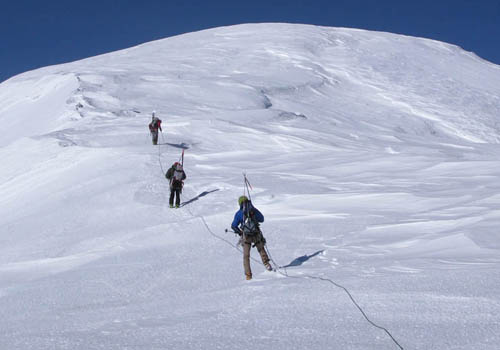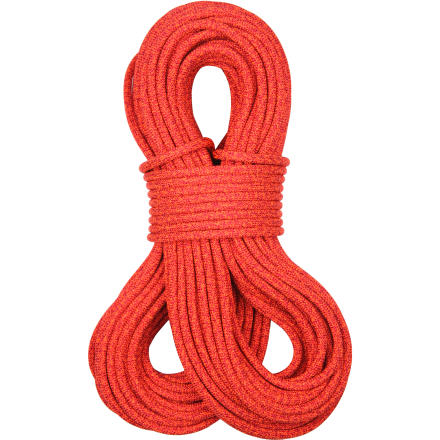Favorite Glacier Rope
I’m slowly assembling my Antarctica kit and pulled out my favorite glacier rope tonight. The sad thing is, I don’t even know the brand, but it doesn’t really matter – what is important is my fast and easy, do-it-yourself modification. Starting with a 60m dry 9.1mm’ish rope, find the center, apply a sharp blade to it, and turn it into two ropes. (That is, two 30m ropes, not two 60m 4.5mm ropes.)
There are a ton of advantages to having two similar/identical 30m ropes for glacier travel, but the main thing is flexibility. You can travel with four people on a 30m, or break into two groups of two each with their own 30, or clip two ends to the middle person and go three or five on a 60, or leave one section in camp if you don’t think you’ll need it, or coil one 30m section up and bury it in a pack if you are traveling tight and fast… and many other options. You can also do the same length rappel with as you would anyway (30m) by tying the two sections together. The one big disadvantage is that you lose the ability to lead 60m pitches with gear placements (the knot won’t pass through biners), but that usually isn’t a big concern with ski mountaineering. One the positive side, since 9.1’s are a bit sketchy for taking big whippers on (at least mine is), you can double up on the ropes and still lead 30m pitches.

Nearing the summit of Sultana as a four-person team on a 60m rope. A full 60 is undeniably nice, but it also slows a team down to the speed of the slowest member (in this case, me as I was draggin' ass for some reason that day). Two 30's would have been better, especially as we also brought another 60m which we left fixed on a tiny little rappel farther back on the ridge.
Another option is to get two of the 30m Beal style Rando ropes, although that seems like a bit of overkill, especially if you already have an older 60. For skinny ropes like this, especially on glaciers, I always use a Munter Hitch for a belay as many of the existing belay devices don’t provide enough stopping power with skinnier, wet ropes.
If you try this, be sure and do a deluxe job melting the ends as with 30m of rope, there is quite a bit of stretching going on and a half-assed melt job won’t last. And, yes, cutting the rope in half voids it’s warranty.
________________________________
Help support StraightChuter.com and mind the cracks with a Sterling Fusion Ion Single Rope – 9.5mm from Backcountry.com. Click on the photo below…
Category: 05 Uphill










That’s generally my favourite system too.
Another favourable attribute (important although morbid..)is that more than one person has a rope in case of incident, i.e. the person with the rope falls into a crevasse while skiing, or falls off the mountain on a technical bit leaving the rest of the group ropeless when there is still technical ground or crevasse danger on the return.
When just two people, it distributes the rope weight evenly and fairly between the team. Nobody ends up skiing with the 60m mega coil. It can speed things up also if coiling duties are divided after a rapel etc. or leapfrogging shorter rapels with ground in between or leaving one rope set up or fixed for something.
When ski-mountaineering in the alps (and in general I guess), I always insist on the 2×30 or 2×40 system. Doug, myself and others decided way back that it should be the “standard” system (at least 9mm because too many just ski with a 6mm rapel line which is good only for rapelling) here around La Grave so that we are always compatible with eachother when just meeting up out of the blue on the ski-hill. Everybody just has their 30m piece in their kit. (and a piece of wood which is standard in my crevasse kit).
It’s just not the same good time melting the rope ends since they stopped using hemp!
We use 8mm Dynema which is super static of course and very light and compact and carried in two pieces for glacier travel as well. ‘Cause it doesn’t stretch a grigri raps on it, too.
Expensive, however, and not good for leading 5.10 or higher where a fall might be expected, but super good in the mountains/glaciers.
For all the aforementioned reasons I’ve been using a 8mm (double) dynamic dry rope cut into 30m sections for many years. For glacier travel and rescue, and occasional emergency rappels it seems more than adequate, and I could use it as a double rope in the unlikely instance I need to lead something. I’m always looking to cut weight for extended ski traverses I’ve been thinking about using 30m sections of 6mm Mammut Powercord and am interested in what you think the pros and cons might be.
A, you talk about using a Beal Rando as a substitute for your 9.1mm 30mm. I was wondering if you could comment on how the different diameters effect what you can use each for. I think the Rando is about a 8mm rope.
Take a look at this test of smaller diameter static and dynamic ropes for glacier travel.
http://www.mra.org/services/grants/…/Using_low_stretch_ropesFinal.pdf
Thanks Frank – here’s another version of the same link:
http://www.mra.org/services/grants/documents/Using_low_stretch_ropesFinal.pdf
Do you use the 30’s in Alaska?
Yes Alaskan’s use two 30’s (8 mm) and sometimes just one, in the chugach, on the kenai and talkeetnas for glacier travel, ski touring/mountaineering, emergency rappels, ridge protection, etc… It is a very versatile and useful setup… Havent tried it in the Alaska Range, but i dont see why not, if i can keep 50′ spacing i would use it, which a team
of three can, And that is my optimal glacier travel number